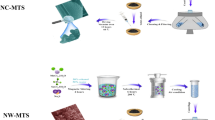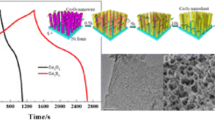Abstract
The reasonable design of electrode materials with high electrochemical activity and stable structure after long cycles can effectively improve the electrochemical performance of supercapacitors. In this paper, Co-doped Ni3S2 supported on Ti3C2/Ni foam (Co-Ni3S2/Ti3C2/NF) composites were prepared using a feasible hydrothermal method. The composite materials were characterized by scanning electron microscopy, X-ray diffraction, and X-ray photoelectron spectroscopy. The results showed that the Co-Ni3S2/Ti3C2/NF materials had a three-dimensional network structure. Electrochemical performance tests were conducted for the Co-Ni3S2/Ti3C2/NF electrode. The prepared Co-Ni3S2/Ti3C2/NF electrode has good electrochemical performance with specific capacitance of 1457 F g−1 at 1 A g−1. At 10 A g−1, the specific capacity after 5000 cycles is 127.35% of the initial specific capacity. The asymmetric supercapacitor with Co-Ni3S2/Ti3C2/NF as the positive electrode and activated carbon (AC) as the negative electrode has an energy density of 30.4 Wh kg−1 at power energy density of 0.8 kW kg−1. This strategy provides a useful method for the design of supercapacitor electrodes with excellent electrochemical performance coated with MXenes.








Similar content being viewed by others
References
Zhu Q, Zhao D, Cheng M et al (2019) A new view of supercapacitors: integrated supercapacitors. Adv Energy Mater 9:1901081. https://doi.org/10.1002/aenm.201901081
Chen D, Chen H, Chang X et al (2017) Hierarchical CoMn-layered double hydroxide nanowires on nickel foam as electrode material for high-capacitance supercapacitor. J Alloys Compd 729:866–873. https://doi.org/10.1016/j.jallcom.2017.07.313
Xia C, Surendran S, Ji S et al (2022) A sulfur self-doped multifunctional biochar catalyst for overall water splitting and a supercapacitor from Camellia japonica flowers. Carbon Energy 4:491–505. https://doi.org/10.1002/cey2.207
Li Q, Liu M, Huang F et al (2022) Co9S8@ MnO2 core-shell defective heterostructure for high-voltage flexible supercapacitor and Zn-ion hybrid supercapacitor. Chem Eng J 437:135494. https://doi.org/10.1016/j.cej.2022.135494
Zhang X, Yang S, Lu W et al (2021) MXenes induced formation of Ni-MOF microbelts for high-performance supercapacitors. J Colloid Interface Sci 592:95–102. https://doi.org/10.1016/j.jcis.2021.02.042
Zhong M, Zhang M, Li X (2022) Carbon nanomaterials and their composites for supercapacitors. Carbon Energy 4:950–985. https://doi.org/10.1002/cey2.219
Rawat S, Mishra RK, Bhaskar T (2022) Biomass derived functional carbon materials for supercapacitor applications. Chemosphere 286:131961. https://doi.org/10.1016/j.chemosphere.2021.131961
Lyu L, Hooch Antink W, Kim YS et al (2021) Recent development of flexible and stretchable supercapacitors using transition metal compounds as electrode materials. Small 17:2101974. https://doi.org/10.1002/smll.202101974
Wu B, Qian H, Nie Z et al (2020) Ni3S2 nanorods growing directly on Ni foam for all-solid-state asymmetric supercapacitor and efficient overall water splitting. J Energy Chem 46:178–186. https://doi.org/10.1016/j.jechem.2019.11.011
Wang Y, Ding Y, Guo X et al (2019) Conductive polymers for stretchable supercapacitors. Nano Res 12:1978–1987. https://doi.org/10.1007/s12274-019-2296-9
Deyba MA, Mele G (2019) PANI@Co-porphyrins composite for the construction of supercapacitors. J Energy Storage 26:101013. https://doi.org/10.1016/j.est.2019.101013
Liu G, Wang B, Liu T et al (2018) 3D self-supported hierarchical core/shell structured MnCo2O4@CoS arrays for high-energy supercapacitors. J Mater Chem A 6:1822–1831. https://doi.org/10.1039/C7TA10140F
Wang X, Shi B, Fang Y et al (2017) High capacitance and rate capability of a Ni3S2@CdS core-shell nanostructure supercapacitor. J Mater Chem A 5:7165–7172. https://doi.org/10.1039/C7TA00593H
Li S, Huang W, Yang Y et al (2018) Hierarchical layer-by-layer porous FeCo2S4@Ni(OH)2 arrays for all-solid-state asymmetric supercapacitors. J Mater Chem A 6:20480–20490. https://doi.org/10.1039/C8TA07598K
Chen Q, Jin J, Kou Z et al (2020) Cobalt-doping in hierarchical Ni3S2 nanorod arrays enables high areal capacitance. J Mater Chem A 8:13114–13120. https://doi.org/10.1039/D0TA04483K
Li K, Li J, Zhu Q et al (2022) Three-dimensional MXenes for supercapacitors: a review. Small Methods 6:2101537. https://doi.org/10.1002/smtd.202101537
Pu S, Wang Z, Xie Y et al (2022) Origin and regulation of self-discharge in MXene supercapacitors. Adv Funct Mater 2208715. https://doi.org/10.1002/adfm.202208715
Ma R, Chen Z, Zhao D et al (2021) Ti3C2Tx MXene for electrode materials of supercapacitors. J Mater Chem A 9:11501–11529. https://doi.org/10.1039/D1TA00681A
Luo Y, Tian Y, Tang Y et al (2021) 2D hierarchical nickel cobalt sulfides coupled with ultrathin titanium carbide (MXene) nanosheets for hybrid supercapacitors. J Power Sources 482:228961. https://doi.org/10.1016/j.jpowsour.2020.228961
Tian YP, Yang CH, Que WX et al (2017) Ni foam supported quasi-core-shell structure of ultrathin Ti3C2 nanosheets through electrostatic layer-by-layer self-assembly as high rate-performance electrodes of supercapacitors. J Power Sources 369:78–86. https://doi.org/10.1016/j.jpowsour.2017.09.085
Guo J, Zhao Y, Ma T (2019) Electrostatic self-assembly of 2D delaminated MXene (Ti3C2) onto Ni foam with superior electrochemical performance for supercapacitor. Electrochim Acta 305:164–174. https://doi.org/10.1016/j.electacta.2019.03.025
Cui Y, Zhang J, Jin C et al (2019) Ionic liquid-controlled growth of NiCo2S4 3D hierarchical hollow nanoarrow arrays on Ni foam for superior performance binder free hybrid supercapacitors. Small 15:1804318. https://doi.org/10.1002/smll.201804318
Wang YG, Song YF, Xia YY (2016) Electrochemical capacitors: mechanism, materials, systems, characterization and applications. Chem Soc Rev 45:5925–5950. https://doi.org/10.1039/C5CS00580A
Li J, Yuan X, Lin C et al (2017) Achieving high pseudocapacitance of 2D titanium carbide (MXene) by cation intercalation and surface modification. Adv Energy Mater 7:1602725. https://doi.org/10.1002/aenm.201602725
Liu J, Zhang L, Wu HB et al (2014) High-performance flexible asymmetric supercapacitors based on a new graphene foam/carbon nanotube hybrid film. Energy Environ Sci 7:3709–3719. https://doi.org/10.1039/C4EE01475H
Wang Z, Su H, Liu F et al (2019) Establishing highly-efficient surface Faradaic reaction in flower-like NiCo2O4 nano-/micro-structures for next-generation supercapacitors. Electrochim Acta 307:302–309. https://doi.org/10.1016/j.electacta.2019.03.227
Chen SG, Li YH, Wu BX et al (2018) 3D meso/macroporous Ni3S2@Ni composite electrode for high-performance supercapacitor. Electrochim Acta 275:40–49. https://doi.org/10.1016/j.electacta.2018.04.152
Zou X, Liu Y, Li GD et al (2017) Ultrafast formation of amorphous bimetallic hydroxide films on 3D conductive sulfide nanoarrays for large-current-density oxygen evolution electrocatalysis. Adv Mater 29:1700404–1700410. https://doi.org/10.1002/adma.201700404
Zhou Y, Tong X, Pang N et al (2021) Ni3S2 nanocomposite structures doped with Zn and Co as long-lifetime, high-energy-density, and binder-free cathodes in flexible aqueous nickel-zinc batteries. ACS Appl Mater Interfaces 13:34292–34300. https://doi.org/10.1021/acsami.1c08108
Feng JX, Wu JQ, Tong YX et al (2018) Efficient hydrogen evolution on Cu nanodots-decorated Ni3S2 nanotubes by optimizing atomic hydrogen adsorption and desorption. J Am Chem Soc 140:610. https://doi.org/10.1021/jacs.7b08521
Jian J, Yuan L, Qi H et al (2018) Sn-Ni3S2 ultrathin nanosheets as efficient bifunctional water-splitting catalysts with a large current density and low overpotential. ACS Appl Mater Interfaces 10:40568. https://doi.org/10.1021/acsami.8b14603
Ding Y, Du X, Zhang X (2021) Cu-Doped Ni3S2 interlaced nanosheet arrays as high-efficiency electrocatalyst boosting the alkaline hydrogen evolution. ChemCatChem 13:1824–1833. https://doi.org/10.1002/cctc.202001838
Zhang D, He W, Zhang Z et al (2019) Structure-design and synthesis of nickel-cobalt-sulfur arrays on nickel foam for efficient hydrogen evolution. J Alloys Compd 785:468–474. https://doi.org/10.1016/j.jallcom.2019.01.184
Gao WK, Qin JF, Wang K et al (2018) Facile synthesis of Fe-doped Co9S8 nanomicrospheres grown on nickel foam for efficient oxygen evolution reaction. Appl Surf Sci 454:46–53. https://doi.org/10.1016/j.apsusc.2018.05.099
Wang X, Wang S, Chen S et al (2020) Facile one-pot synthesis of binder-free nano/micro structured dendritic cobalt activated nickel sulfide: a highly efficient electrocatalyst for oxygen evolution reaction. Int J Hydrog Energy 45:19304–19312. https://doi.org/10.1016/j.ijhydene.2020.05.105
Xia QX, Fu JJ, Yun JM et al (2017) High volumetric energy density annealed-MXene nickel oxide/MXene asymmetric supercapacitor. RSC Adv 7:11000–11011. https://doi.org/10.1039/c6ra27880a
Thotiyl MMO, Freunberger SA, Peng ZQ et al (2013) A stable cathode for the aprotic Li-O2 battery. Nat Mater 12:1050–1056. https://doi.org/10.1038/nmat3737
Xue Q, Pei Z, Huang Y et al (2017) Mn3O4 nanoparticles on layer-structured Ti3C2-MXene towards the oxygen reduction reaction and zinc-air batteries. J Mater Chem A 5:20818–20823. https://doi.org/10.1039/C7TA04532H
Tong X, Li Y, Pang N et al (2021) Co-doped Ni3S2 porous nanocones as high-performance bifunctional electrocatalysts in water splitting. Chem Eng J 425:130455. https://doi.org/10.1016/j.cej.2021.130455
Guo J, Zhao Y, Liu A et al (2019) Electrostatic self-assembly of 2D delaminated MXene (Ti3C2) onto Ni foam with superior electrochemical performance for supercapacitor. Electrochim Acta 305:164–174. https://doi.org/10.1016/j.electacta.2019.03.025
Chou SW, Lin JY (2013) Cathodic deposition of flaky nickel sulfide nanostructure as an electroactive material for high-performance supercapacitors. J Electrochem Soc 160:D178–D182. https://doi.org/10.1149/2.078304jes
Li L, San Hui K, Hui KN et al (2017) Facile synthesis of NiAl layered double hydroxide nanoplates for high-performance asymmetric supercapacitor. J Alloys Compd 721:803–812. https://doi.org/10.1016/j.jallcom.2017.06.062
Liu S, Jun SC (2017) Hierarchical manganese cobalt sulfide core-shell nanostructures for high-performance asymmetric supercapacitors. J Power Sources 342:629–637. https://doi.org/10.1016/j.jpowsour.2016.12.057
Lan Y, Zhao H, Zong Y et al (2018) Phosphorization boosts the capacitance of mixed metal nanosheet arrays for high performance supercapacitor electrodes. Nanoscale 10:11775–11781. https://doi.org/10.1039/C8NR01229F
Sun S, Xie Z, Yan Y et al (2019) Hybrid energy storage mechanisms for sulfur-decorated Ti3C2 MXene anode material for high-rate and long-life sodium-ion batteries. Chem Eng J 366:460–467. https://doi.org/10.1016/j.cej.2019.01.185
Pan Z, Cao F, Hu X et al (2019) A facile method for synthesizing CuS decorated Ti3C2 MXene with enhanced performance for asymmetric supercapacitors. J Mater Chem A 7:8984–8992. https://doi.org/10.1039/C9TA00085B
Wu W, Zhao C, Niu D et al (2021) Ultrathin N-doped Ti3C2-MXene decorated with NiCo2S4 nanosheets as advanced electrodes for supercapacitors. Appl Surf Sci 539:148272. https://doi.org/10.1016/j.apsusc.2020.148272
Wu W, Niu D, Zhu J et al (2019) Hierarchical architecture of Ti3C2@ PDA/NiCo2S4 composite electrode as high-performance supercapacitors. Ceram Int 45:16261–16269. https://doi.org/10.1016/j.ceramint.2019.05.149
Wang F, Zhu Y, Tian W et al (2018) Co-doped Ni3S2@CNT arrays anchored on graphite foam with a hierarchical conductive network for high-performance supercapacitors and hydrogen evolution electrodes. J Mater Chem A 6:10490–10496. https://doi.org/10.1039/C8TA03131B
Kötz R, Carlen M (2000) Principles and applications of electrochemical capacitors. Electrochim Acta 45:2483–2498. https://doi.org/10.1016/S0013-4686(00)00354-6
Chiu CT, Chen DH (2018) One-step hydrothermal synthesis of three-dimensional porous Ni-Co sulfide/reduced graphene oxide composite with optimal incorporation of carbon nanotubes for high performance supercapacitors. Nanotechnology 29:175602. https://doi.org/10.1088/1361-6528/aaaff5
Zhang Z, Huang X, Li H et al (2017) All-solid-state flexible asymmetric supercapacitors with high energy and power densities based on NiCo2S4@ MnS and active carbon. J Energy Chem 26:1260–1266. https://doi.org/10.1016/j.jechem.2017.09.025
Funding
This work was supported by the financial support received from the Natural Science Foundation of China (No. 21875192).
Author information
Authors and Affiliations
Corresponding author
Additional information
Publisher's Note
Springer Nature remains neutral with regard to jurisdictional claims in published maps and institutional affiliations.
Rights and permissions
Springer Nature or its licensor (e.g. a society or other partner) holds exclusive rights to this article under a publishing agreement with the author(s) or other rightsholder(s); author self-archiving of the accepted manuscript version of this article is solely governed by the terms of such publishing agreement and applicable law.
About this article
Cite this article
Tang, M., Shen, J., Zeng, T. et al. MXene/Ni foam supported Co-doped Ni3S2 as a binder-free electrode for enhanced performance of supercapacitors. J Solid State Electrochem 27, 2533–2543 (2023). https://doi.org/10.1007/s10008-023-05543-5
Received:
Revised:
Accepted:
Published:
Issue Date:
DOI: https://doi.org/10.1007/s10008-023-05543-5




